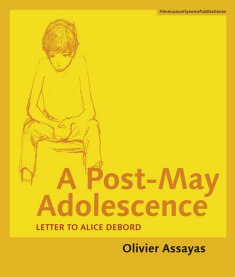By Michael Scoular (The Cascade) – Email
Print Edition: March 20, 2013
 Recalling the 1960s and ‘70s, written in 2005, translated into English by Adrian Martin and Rachel Zerner and published last year, Olivier Assayas’ A Post-May Adolescence is a work of shifting positions, timeframes, tenses and forms – a work of criticism, a memoir and a “letter to Alice Debord.”
Recalling the 1960s and ‘70s, written in 2005, translated into English by Adrian Martin and Rachel Zerner and published last year, Olivier Assayas’ A Post-May Adolescence is a work of shifting positions, timeframes, tenses and forms – a work of criticism, a memoir and a “letter to Alice Debord.”
Assayas’ autobiographical account of his coming of age—from school to practice, political messages to beliefs—is set in a period of remove. Assayas grew up in the time just following the events of May ‘68 in France, and as a filmmaker, Assayas belongs to a rarely-classified generation of French directors neither as radical as those before nor as acceptably standard as the international crossovers of today – a barely-noticeable wave after the wave (at least in quantifiable size). This in-betweenness, though valuable in its own way, means that as Assayas’ book opens, it is with the recognition that politically “it was all over,” and as it continues Assayas always considers with self-effacement his own film and art.
But because there was this “after” of the era, the pressure of a standard briefly set up then fallen before, Assayas enters as a teenager into a torrent of ideas—some attractive, some attached—that not only exist as texts but present themselves as possible actions. The volatility of the school day, the impulsive, accelerated action after its conclusion, “a larger horizon than the one given to young people today,” gives Assayas’ memories of education typical unsureness, but also a forcefulness that, though rash and momentary, exceeded silent revolt of thought against “the stifling solitude of decomposed collective values.”
Assayas was a part of school vandalism, strikes, marches and pamphlet distribution, but for the most part this is not aggrandized; Assayas—at the time, apparently, and certainly now—is against the romanticism, the standardized, reductive view of the era (he rejects the term “movement” entirely), often shrunk into symbols and clothing and copied images. This was real, problematic and as complicated as transition always is when viewed from ground level.
Assayas picks apart the dogma and methods that were no better than the ones they were seeking to replace, but what surfaces is an overall changeability – allegiances could switch as groups collapsed or disbanded, the one regularity of alternative presses were their short life-span but also their constant emergence, and “the frisson of physical disgust provoked by discussions with interlocutors who, the day before, I would have considered close friends concerning the veracity or lack thereof and the significance or lack thereof” of Solzhenitsyn, Sartre, Orwell and other authors of division.
Translated from French, Assayas’ prose is dense, though this is not unfitting given the type of political existence that is being waded through, the collision of irreducible memory and an articulate present concerned with many of those same ideas. While the perspective gained by time means these can be named, there is still a constant questioning. This is not sure, this is “how did those events really come to be,” and “how did they come to form what is at present.” The same questions, then, continue to be posed today, and are in Assayas’ most recent film Apres mai (in limited release in a matter of months), a film linked closely to this text, and in the same way caught between the reformation of—becoming immersed in memory—and the gaining of perspective to see things as they truly are – though things will always be limited by this single point of view.
The major political conviction of Assayas’ youth as well as those around him, naturally, never finds resolution, but where this book finds its most alive portions and finds a stepping-off point is in Assayas’ discovery of personal voice through art – the major one being Guy Debord and situationism. “Thought and style are one and the same,” Assayas writes, introducing the major part of his life where Debord became an influence, (also the focus of two attached essays, one coming from his time as critic writing for Cahiers du Cinema) and this style comes to mean many different things.
There is the concept of detournement, “the diversion of pre-existing aesthetic elements which are then turned against their original meaning and put to new use,” which is part of the case for Assayas’ films’ stability in look even as they pursue radical ideas, and there are the young discoveries that shape a sensibility towards interpretation of the world: Warhol, Ginsberg and importantly the music of The Velvet Underground (and later The Clash, before Assayas turns to criticize what punk rock cleared away and left in replace). With Assayas, this is not simply reference or name-dropping, but a considered understanding through another that has in turn become the new form of his own personality – a subversion become convention turned again into new ways of disruption and engagement, a situation from the past, still present.


